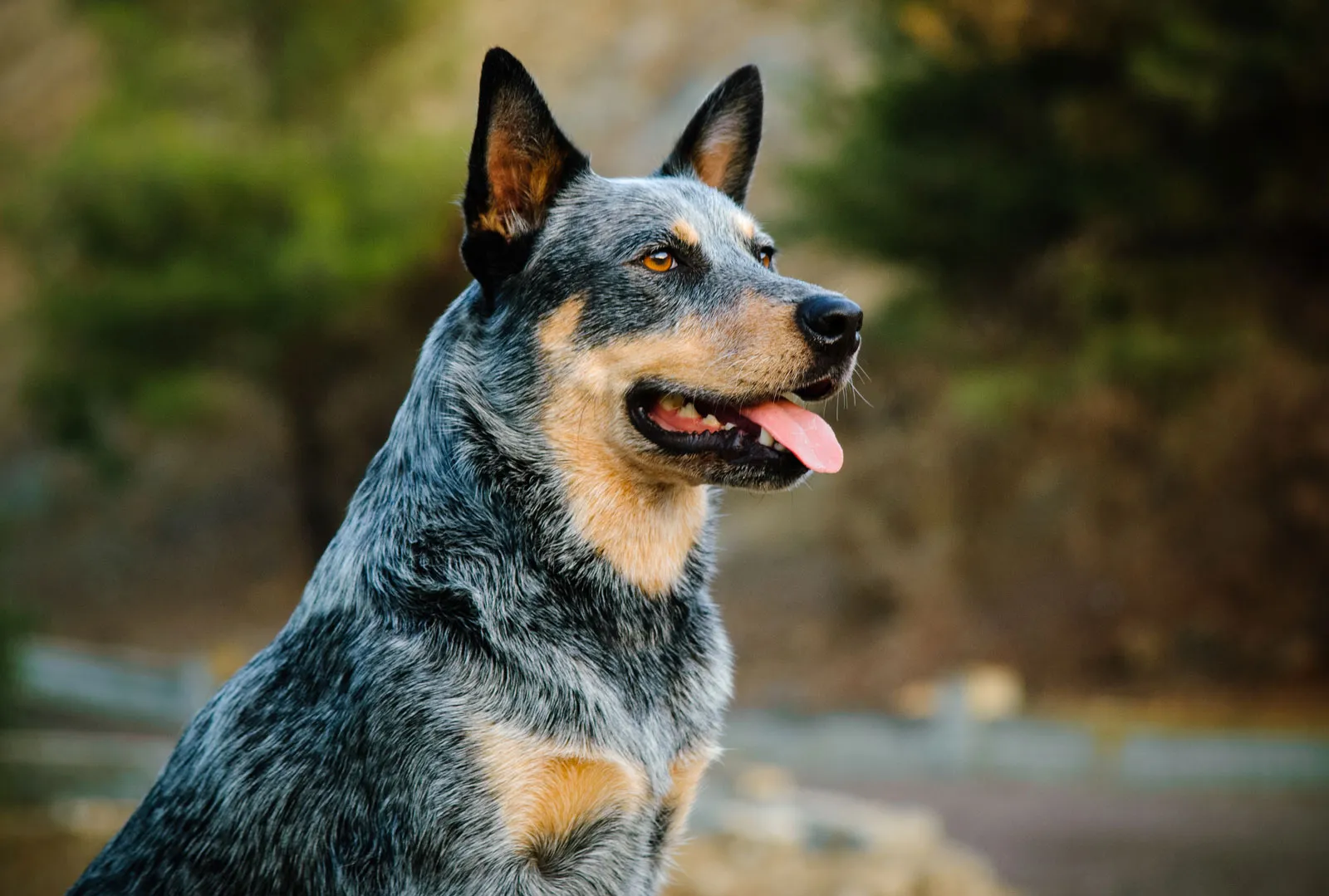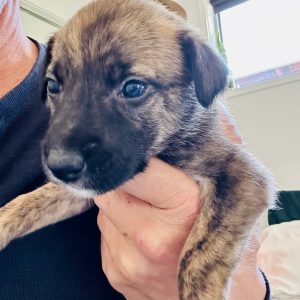Australian Cattle Dog
Showing the single result

As is to be expected, the Australian Cattle Dog was bred to herd cattle. They’re also known as Blue Heelers, Australian Heelers, or Queensland Heelers. When they’re not doing their designated task of keeping rowdy livestock under control, they’re likely by their owner’s side, as this breed bonds very well with humans.
Their unwavering work ethic and exceptional physical abilities have made them popular farm dogs all over the world. These are courageous, tireless, and focused working dogs who just so happen to be gentle with humans and protective of their territory. While they are a challenge for novice owners, experienced owners will get the most out of these dogs.
Temperament
While they’re used to working with cattle and other livestock, Australian Cattle Dogs are devoted and loving towards their humans. It’s true that they’re at their happiest when they have a task to complete, but during their downtime they do love to play around and snuggle up to their owners. This affectionate nature shines through almost all the time, in fact – they’re one of a couple of breeds called “velcro” dogs because of how close they are to their owners. They don’t tend to be aggressive, but because they were also meant to guard their owner’s property, they may be wary of strangers. Australian Cattle Dogs have a high prey drive and may not get along with smaller animals. They do enjoy the company of other dogs once proper introductions are made. This breed does tend to nip and chew on objects (and people), but this tendency can be addressed with early training. All in all, Australian Cattle Dogs make great all-around working dogs and family pets, if their owner is able to put in the training work necessary.The Ultimate Guide to Australian Cattle Dog
Origins
The Australian Cattle Dog was bred specifically to do one job: help Australian ranchers to herd cattle on their expansive properties. It is thanks to the Australian Cattle Dog that the cattle industry in Australia took off like it did. The British settlers in Australia originally brought the Smithfield sheepdog with them to serve as a herding dog. However, the dogs did not cope well with Australia’s climate and terrain. They decided to mix these original sheepdogs with the local Dingo to create a dog that was more suited to the harsh conditions of Australia. There were many cross-breedings that happened before the ancestors of the modern Australian Cattle Dog were born. Blue-colored dogs ended up being the most popular with ranchers, and they came to be known as Blue Heelers. This name is now being used interchangeably with Australian Cattle Dog, which is the official name of the breed. The Australian Cattle Dog eventually made its way to the U.S. after World War II, and became one of the most popular herding breeds in the country. To this day they serve as adept herding dogs and farm dogs, though some are now kept as pets or competition dogs as well.
Key Characteristics of Australian Cattle Dog
| Australian Cattle Dog | While they’re used to working with cattle and other livestock, Australian Cattle Dogs are devoted and loving towards their humans. It’s true that they’re at their happiest when they have a task to complete, but during their downtime they do love to play around and snuggle up to their owners.
This affectionate nature shines through almost all the time, in fact – they’re one of a couple of breeds called “velcro” dogs because of how close they are to their owners. They don’t tend to be aggressive, but because they were also meant to guard their owner’s property, they may be wary of strangers.
Australian Cattle Dogs have a high prey drive and may not get along with smaller animals. They do enjoy the company of other dogs once proper introductions are made. This breed does tend to nip and chew on objects (and people), but this tendency can be addressed with early training. All in all, Australian Cattle Dogs make great all-around working dogs and family pets, if their owner is able to put in the training work necessary. |
| Exercise Needs | “High energy” only just begins to describe the Australian Cattle Dog’s ability to work, play, and run for hours on end. They have impressive stamina and athletic ability, as they have to outrun, outsmart, and outmaneuver livestock that is many times their size and weight.
Most Australian Cattle Dogs will require at least two hours of vigorous play or exercise each day to prevent them from being bored. A bored Australian Cattle Dog may tend to develop destructive behaviors such as digging or chewing on your belongings. A tired Australian Cattle Dog is a well-behaved Australian Cattle Dog.
Their exercise time can be split up into shorter sessions, as most humans will lack the stamina to keep up with an Australian Cattle Dog for the full duration. It’s best to have an outdoor space where the Australian Cattle Dog can run around off-leash, preferably a fenced yard with high walls the dog cannot jump over. Their prey drive can mean that they take off after smaller prey animals such as squirrels, rabbits, or mice, and it may be almost impossible to catch them.
Dog sports and agility training are also excellent activities for Australian Cattle Dogs, as their physical traits allow them to excel at any task that requires balance, quickness, and intelligence. |
| Australian Cattle Dog Grooming | Australian Cattle Dogs have a double coat of fur that bears the signature merle coloring that earned them the nickname of Blue Heeler. They have a short outer coat that is weather-resistant, and a dense undercoat. Their overall grooming needs are low, but they do have to be kept clean.
Australian Cattle Dogs do not shed much throughout the year, but do have periods where they blow coat and their undercoat comes out in clumps. Most owners get by with brushing their Australian Cattle Dog around once or twice a week, but more frequent brushing during spring and fall will be necessary to mitigate their shedding.
A bath every month or every other month is sufficient for most Australian Cattle Dogs, except if your dog gets particularly dirty after rolling around in dirt or mud. Tooth brushing is important to do at least three or four times a week to get rid of tartar buildup and bacteria. Nail trimming can be done as necessary, typically around every three to four weeks. |
| Australian Cattle Dog Training | Because they bond so well with their owners and with humans in general, Australian Cattle Dogs are eager to please and respond very well to regular training. Their intelligence allows them to pick up commands quickly, and they can be trained to perform a variety of tasks.
They don’t tend to be stubborn or independent, so training is easy for the most part. One area where they need special attention is their tendency to bite or nip, even during play. This behavior can be trained out, but it needs to happen at an early age. Teach your Australian Cattle Dog that play stops when they start nipping, and they’ll catch on fast.
Australian Cattle Dogs benefit from an experienced owner who can apply rules firmly and consistently. They’re not overly sensitive to disruptions in training or lack of consistency, but an Australian Cattle Dog will be at their best when they know they can depend on you for structure and guidance.
Australian Cattle Dogs do not appreciate punishments or harsh language, and may become uncooperative with this training style. Positive reinforcement is more effective in getting your Australian Cattle Dog to obey commands. |
| Australian Cattle Dog Lifespan And Health Issues | Australian Cattle Dogs have an above-average lifespan for dogs of their size, living for 12 to 16 years. Australian Cattle Dogs may be prone to:
|
| Australian Cattle Dog Size and Space Requirements | The Australian Cattle Dog is a medium-sized breed, standing between 18 to 20 inches at the shoulder for males, and 17 to 19 inches for females. Adult male Australian Cattle Dogs will weigh between 35 to 50 pounds, and females weigh around the same.
Despite their compact size, they do need a lot of space to stretch out and smaller apartments may feel confining for this high-energy breed. These dogs were bred with the vast expanses of the Australian countryside in mind.
Australian Cattle Dogs kept as pets will need a secure, fenced outdoor space in which to play. The fence will need to be very high, as there are reports of Australian Cattle Dogs jumping over 6-foot-high fences with a running start.
Because they’re a “velcro” dog, they will need to be in close proximity to their owners for most of the time. Being left alone to wait for long periods of time will make them very unhappy, which may result in destructive behaviors. As such, they will also need to live indoors with their family. |
Other considerations:
- Australian Cattle Dogs are suited to any climate, but are especially good in very hot and dry temperatures.
- Australian Cattle Dogs will naturally herd anything – including the owner and their family. Early socialization and training are necessary to teach them that this behavior has a time and a place.
- Australian Cattle Dogs can get along very well with children if their tendency to nip and bite has been trained out of them.
How can I take good care of my Australian Cattle Dog or Puppy?
Proper socialization
Australian Cattle Dogs have a strong instinct to perform herding actions and their high intelligence can make them mischievous. It is important to socialize your Australian Cattle Dog puppy when you bring them home so that they get along well with other animals and people. Most puppies will be released to new owners at around 8 weeks old, and it is at this time that Australian Cattle Dogs will be receptive to new experiences.
Proper nutrition
Australian Cattle Dogs are high-energy working dogs, so it’s important to get them high-quality, premium dog food. A good idea is to weigh out your dog’s food so that you can be sure they’re getting the right amount each day. For specific amounts, consult your veterinarian so they can give a recommendation based on your dog’s health and expected adult weight.
Up-to-date vaccinations
Upon taking home your Australian Cattle Dog puppy, you should contact your veterinarian to get a vaccination schedule. Vaccination schedules will vary depending on the prevalence of common transmissible dog diseases in your area. Follow this schedule to the best of your ability so that your dog is protected.
Most Asked Australian Cattle Dog Questions
-
+How Much do Australian Cattle Dog Puppies Cost
